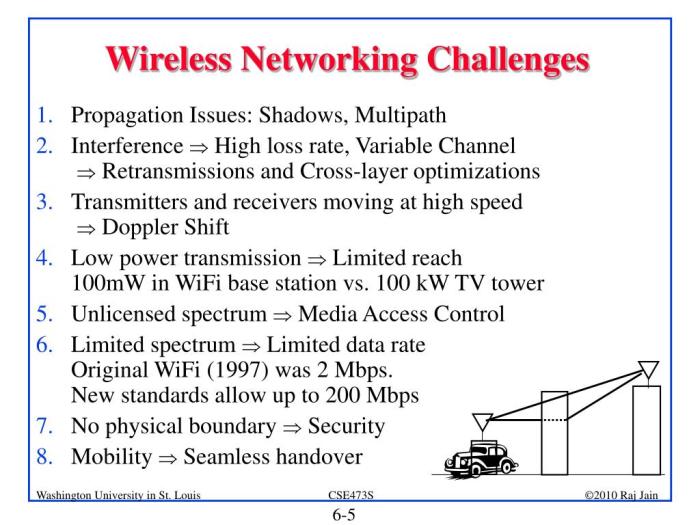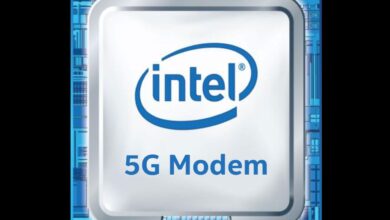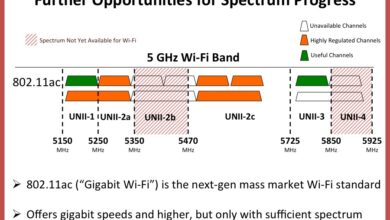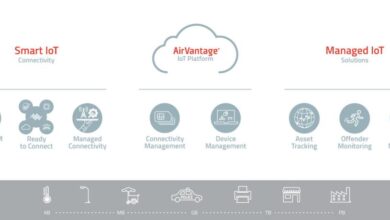The Challenges of Integrating Cellular and Wifi Networks
The challenges of integrating cellular and wifi networks are multifaceted and complex. Different technologies, operating principles, and historical evolutions create hurdles in seamless interoperability. From coverage limitations and security concerns to the intricacies of user experience and cost considerations, achieving a unified and efficient hybrid network presents significant obstacles.
This exploration delves into the intricacies of merging cellular and Wi-Fi, examining the technical, practical, and financial difficulties inherent in this endeavor. We’ll uncover the fundamental differences between these technologies, highlighting the challenges in managing disparate protocols, synchronizing data transmission, and addressing potential security risks. A thorough analysis of existing systems, along with potential future directions, will also be explored.
Introduction to Network Integration Challenges
Integrating cellular and Wi-Fi networks presents a complex array of challenges, stemming from fundamental differences in their underlying technologies and operational principles. The seamless fusion of these two crucial communication mediums is not a straightforward task, requiring careful consideration of various factors to ensure optimal performance and user experience. These networks, while both vital for modern communication, operate on distinct architectures and have evolved along different historical trajectories.The core issue lies in the contrasting nature of cellular and Wi-Fi networks.
Cellular networks, designed for wide area coverage, prioritize mobility and connection across varying environments. Wi-Fi, conversely, excels in localized high-speed data transfer within a confined area. Reconciling these disparate strengths and weaknesses demands innovative solutions to overcome the challenges in their integration. This necessitates a deep understanding of their individual operational principles, historical development, and limitations.
Fundamental Differences in Technology
Cellular networks leverage radio waves for communication over extended distances, supporting diverse devices in motion. Their architecture relies on a hierarchical structure of base stations connected to a central network. Wi-Fi, on the other hand, utilizes radio waves within a limited range for high-speed data transmission, commonly found in homes and offices. Its architecture is typically more decentralized, focusing on local connectivity.
Operational Principles and Architectural Approaches
Cellular networks utilize a cellular structure, dividing geographical areas into cells, each served by a base station. This allows for dynamic allocation of resources and handoffs between cells as devices move. Wi-Fi networks, employing a star topology or mesh, primarily function within a localized area. The network’s access point acts as a central hub, managing communication within the defined range.
Historical Context and Evolution
Cellular networks evolved from early analog systems to the sophisticated digital standards used today, emphasizing continuous improvement in bandwidth and coverage. Wi-Fi technologies, initially developed for local area networks, have advanced rapidly, enabling higher speeds and greater capabilities for wireless data transfer. This different evolutionary path contributes to the complexity of integrating the two technologies.
Examples of Hybrid Systems and Their Limitations
Existing hybrid cellular/Wi-Fi systems often utilize cellular networks for wider coverage and Wi-Fi for higher throughput within specific areas. However, limitations include seamless handoffs between the networks, interference between signals, and managing varying quality of service (QoS) requirements across different technologies. For instance, some systems may struggle with maintaining consistent speeds during transitions between cellular and Wi-Fi, or experience signal degradation in areas with overlapping coverage.
Such systems highlight the challenges in achieving true synergy between the two networks.
Interoperability Issues
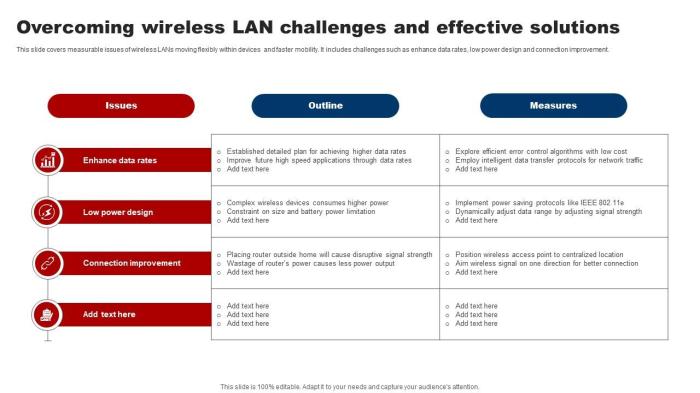
Integrating cellular and Wi-Fi networks presents significant challenges, primarily stemming from the fundamental differences in their design, protocols, and functionalities. These disparities create hurdles in achieving seamless data exchange and consistent user experience. The resulting network fragmentation can impact performance, reliability, and overall user satisfaction.Different technologies, protocols, and standards employed by cellular and Wi-Fi networks make direct and seamless communication difficult.
Addressing these interoperability issues is crucial for creating a unified and efficient network infrastructure. The lack of standardized communication protocols between cellular and Wi-Fi networks can cause data loss, delays, and even network instability.
Integrating cellular and Wi-Fi networks presents a myriad of technical hurdles. Security concerns are amplified, though, by the recent surge in enterprise spyware threats, reaching an all-time high. This rise in malicious activity, detailed in a recent report at enterprise spyware threats reach all time high , further complicates the already complex task of building secure, reliable networks for businesses.
The challenge, then, is not just technical but also involves navigating a constantly evolving threat landscape.
Key Technical Hurdles to Interoperability
The differing architectures of cellular and Wi-Fi networks present several technical obstacles to achieving seamless interoperability. These include, but are not limited to, distinct protocols and standards, varying data transmission speeds, and inconsistencies in frequency bands.
- Different Protocols and Standards: Cellular networks utilize protocols like GSM, UMTS, LTE, and 5G, while Wi-Fi relies on IEEE 802.11 standards. These disparate protocols make direct communication challenging without complex translation mechanisms. The varying standards also impact the types of data that can be transmitted and the efficiency of the transmission process.
- Data Transmission Synchronization Challenges: Synchronizing data transmission and reception between cellular and Wi-Fi networks is crucial for seamless data flow. However, differences in packet sizes, transmission speeds, and latency introduce difficulties. This disparity can lead to dropped packets, data loss, and a degraded user experience. For example, a real-time video stream might experience significant buffering or interruptions if the synchronization isn’t effectively managed.
- Frequency Band and Power Level Incompatibility: Cellular networks operate across various frequency bands, while Wi-Fi typically operates in the 2.4 GHz and 5 GHz bands. These differences in frequency bands can cause interference and limit the range of coverage. Furthermore, cellular networks use higher power levels compared to Wi-Fi, leading to potential interference and signal congestion in shared environments.
Examples of Network Fragmentation
Network fragmentation manifests in various scenarios, impacting user experience and network efficiency.
- Mobile Device Connectivity Issues: Users might experience intermittent connectivity or slow data speeds when transitioning between cellular and Wi-Fi networks. The seamless handover between the two networks is a crucial but often complex process. The lack of seamless handover can lead to a noticeable performance drop when switching between cellular and Wi-Fi networks.
- Internet of Things (IoT) Device Integration Problems: IoT devices relying on both cellular and Wi-Fi connectivity face difficulties in coordinating data transmission. Different protocols, bandwidth limitations, and power consumption requirements complicate the process. For example, smart home devices that require constant communication with a central hub might experience significant delays or failures if the transition between cellular and Wi-Fi is not properly managed.
Coverage and Capacity Limitations
The integration of cellular and Wi-Fi networks promises enhanced connectivity, but inherent limitations in coverage and capacity pose significant challenges. Achieving seamless coverage across diverse environments, from densely populated urban areas to sparsely populated rural regions, requires careful consideration of the strengths and weaknesses of each technology. Understanding these limitations is crucial for effective network design and optimization.Extending network reach beyond the limitations of either cellular or Wi-Fi alone demands innovative strategies.
The trade-offs between the coverage area and network capacity become paramount in such integrated systems, demanding careful balancing to ensure adequate service across all user segments.
Cellular Coverage Limitations
Cellular networks, while offering broad geographical coverage, often face limitations in densely built-up areas or indoors. Signal penetration through obstacles like buildings or foliage can significantly weaken the signal strength. This is particularly pronounced in urban canyons or dense forests, impacting the quality of service. Moreover, cellular infrastructure, while extensive in some areas, is often insufficient to handle peak demand in highly populated urban centers.
Wi-Fi Coverage Limitations
Wi-Fi networks, in contrast, typically provide excellent coverage within a confined area, such as a home or office. However, their range is significantly limited compared to cellular networks. Extending Wi-Fi coverage over large distances requires extensive infrastructure deployment, which can be costly and logistically complex. The signal strength degrades rapidly with distance, making it challenging to maintain reliable connectivity in expansive outdoor areas.
Comparative Analysis of Coverage Capabilities
| Feature | Cellular | Wi-Fi |
|---|---|---|
| Coverage Area | Extensive, spanning vast geographical regions | Limited, confined to a localized area |
| Signal Penetration | Can be affected by obstacles, particularly indoors | Relatively unaffected by obstacles within a limited range |
| Infrastructure Requirements | Requires substantial infrastructure, but generally less intensive than Wi-Fi mesh systems | Requires significant infrastructure, especially for extended coverage |
This comparative analysis highlights the distinct strengths and weaknesses of each technology, illustrating the need for strategic integration to maximize overall network coverage.
Impact on Network Capacity
Integrating cellular and Wi-Fi networks presents a complex interplay of coverage and capacity. The combined usage can significantly improve the overall network capacity, particularly in areas where one technology excels. For example, during peak hours, cellular networks can offload traffic to Wi-Fi hotspots, mitigating congestion and maintaining service quality. However, the capacity of the integrated network is not simply the sum of the individual capacities.
Integrating cellular and Wi-Fi networks presents a host of technical hurdles, from spectrum overlap to signal interference. This complexity is particularly apparent when considering the geopolitical landscape, like the intricate relationship between Google and the Chinese government, which raises questions about data localization and censorship. Ultimately, navigating these challenges requires careful consideration of both technical and political factors.
The performance relies heavily on the efficiency of the handover mechanisms and the ability of the network to balance traffic across both technologies.
Addressing Peak Demands
When both cellular and Wi-Fi networks are used concurrently, the combined system can better handle peak demand periods. The integration allows for seamless handover between technologies, ensuring uninterrupted service for users. For instance, a user moving from a Wi-Fi hotspot to an area with limited Wi-Fi coverage will experience a smooth transition to the cellular network. Efficient handover mechanisms are critical for maintaining service quality and preventing disruptions during peak hours.
Integrating cellular and Wi-Fi networks presents a host of technical hurdles, from managing overlapping frequencies to ensuring seamless data transfer. Imagine the complexity of trying to coordinate the signals, like a conductor leading an orchestra of radio waves! Recent advancements like point and snoot introducing the nose mouse offer intriguing possibilities for improving signal processing, which could potentially simplify the integration of these networks.
Ultimately, these challenges require innovative solutions for a future of interconnected devices.
The effectiveness of this combined system depends on the sophistication of the integration algorithms, which optimize resource allocation and data routing between the two networks.
Security and Privacy Concerns
Integrating cellular and Wi-Fi networks presents significant security and privacy challenges. The inherent differences in the security protocols and infrastructure of each technology create vulnerabilities that must be addressed to ensure data integrity and user confidentiality. These vulnerabilities are amplified when vast amounts of user data traverse both networks. The potential for unauthorized access and data breaches becomes a critical concern.
Security Vulnerabilities in Integrated Networks
The combination of cellular and Wi-Fi networks introduces several new security risks. Cellular networks often rely on 3GPP standards, while Wi-Fi typically uses IEEE 802.11 protocols. These distinct approaches can create vulnerabilities in the connection points where both networks interface. For example, a weak security protocol on the Wi-Fi side could compromise the entire integrated system. Attackers could potentially exploit these gaps to gain unauthorized access to user data traversing both networks.
Comparison of Security Protocols and Encryption Methods
Cellular networks commonly utilize protocols like 3GPP security mechanisms for authentication and encryption. These protocols are designed for robust security in mobile environments. However, the security measures for Wi-Fi can vary significantly depending on the specific protocol in use. For instance, WPA2 and WPA3 offer different levels of encryption strength, and older implementations may be susceptible to vulnerabilities.
This disparity in security mechanisms highlights the potential for mismatches and vulnerabilities in the integrated network.
Potential for Data Breaches and Unauthorized Access
When cellular and Wi-Fi networks are combined, the attack surface increases. Data breaches can occur at any point along the integrated network path, from the user’s device to the server. An attacker exploiting a vulnerability in one network segment could potentially gain access to data traversing the other network. For example, a compromised Wi-Fi hotspot could allow unauthorized access to sensitive cellular data being transmitted.
Moreover, the integration of different encryption standards creates potential points of weakness. If one protocol is weaker, the entire integrated system becomes susceptible to compromise.
Privacy Implications of Integrating User Data
Integrating user data from both cellular and Wi-Fi networks raises significant privacy concerns. Cellular networks typically collect data about user location and activity, while Wi-Fi networks gather information about devices and applications used. Combining this data can create a detailed profile of user behavior and habits. This integrated profile could be used for targeted advertising, or even for unauthorized tracking.
Furthermore, the potential for data breaches and misuse of personal information becomes significantly higher. The risk of unauthorized access to a user’s complete digital footprint increases dramatically with the merging of data streams.
Risks Associated with Diverse Security Protocols
Integrating diverse security protocols can lead to several potential risks. Different encryption strengths, varying authentication mechanisms, and inconsistencies in security policies can create vulnerabilities in the integrated system. For example, if one network uses a less secure protocol, it can become a weak point for the entire integrated system. This can create a chain reaction, potentially compromising the entire integrated network, as seen in several reported cases of cross-platform vulnerabilities in existing networks.
Careful consideration and standardized protocols are essential for mitigating these risks.
Cost Considerations
Integrating cellular and Wi-Fi networks presents a complex financial landscape. The upfront investment and ongoing maintenance costs can vary significantly depending on the scale of the project, the specific technologies employed, and the desired level of performance. Understanding these factors is crucial for successful planning and budget allocation.
Financial Implications of Integration
The integration of cellular and Wi-Fi networks introduces a multifaceted cost structure that extends beyond the individual technologies. It encompasses not only the initial capital expenditure but also the ongoing operational costs, including maintenance, upgrades, and staff training. Careful consideration of these factors is essential for long-term financial viability.
Deploying and Maintaining Each Technology Separately
Deploying cellular networks involves substantial capital expenditures for infrastructure, including cell towers, antennas, and network equipment. Ongoing maintenance costs cover things like equipment upkeep, technician salaries, and regulatory compliance. Wi-Fi deployment costs depend on the scale and sophistication of the system. For small-scale deployments, the capital expenditure is often lower, while large-scale deployments can be comparable to cellular.
Maintenance for Wi-Fi includes routine equipment checks, security updates, and troubleshooting.
Managing Hybrid Infrastructure
Managing a hybrid cellular and Wi-Fi infrastructure introduces additional operational costs. These include the expenses associated with integrating and coordinating the two networks to ensure seamless user experience. This necessitates specialized personnel with expertise in both cellular and Wi-Fi technologies. Managing network traffic and guaranteeing consistent quality of service across both networks adds to the operational overhead.
Capital Expenditures and Operational Expenses
Capital expenditures (CapEx) cover the initial investments in equipment and infrastructure. Examples include the cost of cellular base stations, Wi-Fi access points, and network management software. Operational expenditures (OpEx) encompass ongoing costs, such as maintenance, repairs, staff salaries, and electricity consumption. The balance between CapEx and OpEx often depends on the specific integration strategy.
Minimizing Total Cost of Ownership
Several strategies can help minimize the total cost of ownership for combined networks. Careful planning and selection of appropriate technologies are key. Consider the long-term needs and scalability requirements. Utilizing cloud-based network management solutions can reduce the need for on-site personnel and potentially lower OpEx. Efficient use of existing infrastructure where possible can significantly reduce the overall investment.
Optimizing network configurations to minimize bandwidth consumption can also decrease operational expenses. Furthermore, selecting energy-efficient equipment can reduce electricity costs over time.
User Experience and Management: The Challenges Of Integrating Cellular And Wifi Networks
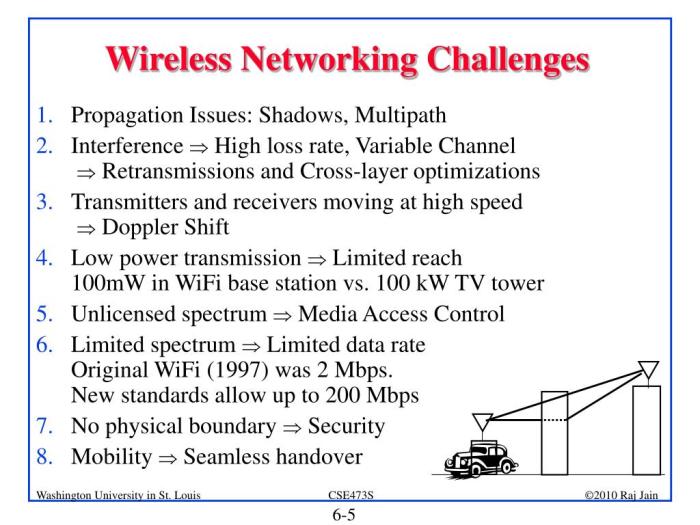
Seamless integration of cellular and Wi-Fi networks hinges on providing a consistent and intuitive user experience. Users shouldn’t notice the shift between technologies; the experience should feel fluid and reliable, regardless of the network in use. This requires careful planning and execution, addressing potential disruptions and optimizing performance in mixed-network environments.A key challenge lies in ensuring that applications and services function flawlessly when switching between cellular and Wi-Fi.
This transition must be transparent, with minimal interruption to the user’s workflow. Furthermore, effective management of network resources is crucial for maximizing efficiency and minimizing congestion, especially when both technologies operate simultaneously.
Ensuring Consistent User Experience
Maintaining a consistent user experience across disparate networks demands careful consideration of application behavior. Applications must be designed to adapt dynamically to network conditions. This includes automatically switching between networks based on factors like signal strength, data speed, and cost. For example, video streaming applications might automatically switch to Wi-Fi when available, preserving data usage on cellular networks for critical tasks.
Managing User Transitions
Transitioning users between cellular and Wi-Fi networks should be a seamless process. A well-designed system will use network signal strength and data speed to determine the optimal network for the task at hand. Applications should handle network selection automatically, without user intervention, as much as possible. This reduces the cognitive load on the user and ensures a smooth transition.
Optimizing User Experience in Simultaneous Use
Simultaneous use of cellular and Wi-Fi networks requires sophisticated prioritization mechanisms. For example, high-priority applications like real-time communication (e.g., video calls) should be prioritized on the faster Wi-Fi network, while background tasks can be shifted to the cellular network. This strategy optimizes performance and minimizes delays, ensuring a high-quality experience for the user.
Network Management with Diverse Technologies
Managing the integration of cellular and Wi-Fi networks requires a comprehensive approach to network management. Centralized monitoring tools are essential for tracking network performance, identifying bottlenecks, and proactively addressing issues. Network administrators must have visibility into both networks and be able to adjust configurations in real-time to optimize performance. This includes monitoring bandwidth usage, signal strength, and device connections across both networks.
Detailed logs of network activity will aid in identifying problems and potential areas for improvement.
User-Friendly Transition Strategies
User-friendly transition strategies are critical to the success of integrated cellular and Wi-Fi networks. A common approach involves using visual cues to inform the user about the current network connection. For instance, an indicator could change color to reflect the switch between cellular and Wi-Fi. Furthermore, providing clear explanations about data usage and cost can enhance user trust and satisfaction.Examples of user-friendly strategies include automatic network switching for specific tasks, such as using Wi-Fi for downloading large files while maintaining cellular connectivity for real-time communication.
Another example is clear and concise messaging that informs the user about the network switch, without disrupting the ongoing task.
Future Trends and Research Directions
The convergence of cellular and Wi-Fi networks is accelerating, driving innovation and presenting exciting possibilities for future connectivity. This evolution necessitates a forward-looking approach to address the inherent challenges and unlock the full potential of integrated networks. Future trends are focused on overcoming limitations and enhancing user experiences through advanced technologies and research.Emerging trends in network integration are impacting the design and implementation of future systems.
This includes a shift towards more sophisticated architectures, enhanced interoperability, and the integration of diverse technologies.
Emerging Trends in Network Integration
The integration of cellular and Wi-Fi networks is evolving rapidly, driven by the demand for seamless connectivity and high-speed data transmission. Key trends include the development of more sophisticated network architectures, enhanced interoperability protocols, and the integration of various technologies. These developments are crucial for addressing existing limitations and creating a more efficient and user-friendly network infrastructure.
Potential Solutions for Integration Challenges
Several strategies are being explored to address the existing integration challenges. These solutions aim to optimize performance, improve user experience, and enhance security. One promising approach involves dynamic spectrum sharing, enabling both cellular and Wi-Fi networks to utilize available spectrum more effectively. Another area of focus is the development of advanced signal processing techniques to mitigate interference between the two technologies.
Key Areas of Future Research and Development
Future research and development in network integration focus on several key areas. These areas include exploring novel spectrum management techniques, developing more sophisticated interference mitigation algorithms, and designing robust security protocols for integrated networks. Furthermore, research is being conducted to create more efficient and intelligent network management systems.
Potential Benefits and Limitations of Next-Generation Technologies, The challenges of integrating cellular and wifi networks
Next-generation technologies like 5G and Wi-Fi 6E offer significant benefits for integrated networks. 5G’s high bandwidth and low latency capabilities can enhance the performance of applications demanding high data rates, such as augmented reality (AR) and virtual reality (VR). Wi-Fi 6E’s increased spectrum availability will further expand the capacity of Wi-Fi networks, providing better support for high-density areas.
However, limitations remain. 5G deployment faces challenges related to infrastructure costs and network coverage. Wi-Fi 6E’s success relies on the availability of compatible devices and the efficient management of the newly available spectrum.
Comparison of Current and Future Research in Cellular and Wi-Fi Network Integration
Current research in cellular and Wi-Fi integration focuses on enhancing interoperability and optimizing spectrum utilization. Future research will emphasize the development of more intelligent and adaptive network architectures, allowing for dynamic spectrum allocation and seamless handover between cellular and Wi-Fi networks. The integration of artificial intelligence (AI) and machine learning (ML) techniques will play a vital role in optimizing network performance and improving user experience.
This transition will lead to more efficient resource allocation, proactive interference management, and enhanced security.
Wrap-Up
Ultimately, integrating cellular and Wi-Fi networks presents a complex interplay of technical, operational, and economic factors. The quest for a unified, efficient, and secure hybrid network requires careful consideration of interoperability issues, coverage limitations, security protocols, and cost implications. While numerous challenges remain, the potential benefits of seamless integration between these two critical technologies remain a driving force for ongoing research and development.
Future advancements in 5G and Wi-Fi 6E, coupled with innovative solutions to current obstacles, promise a more integrated and user-friendly future.

